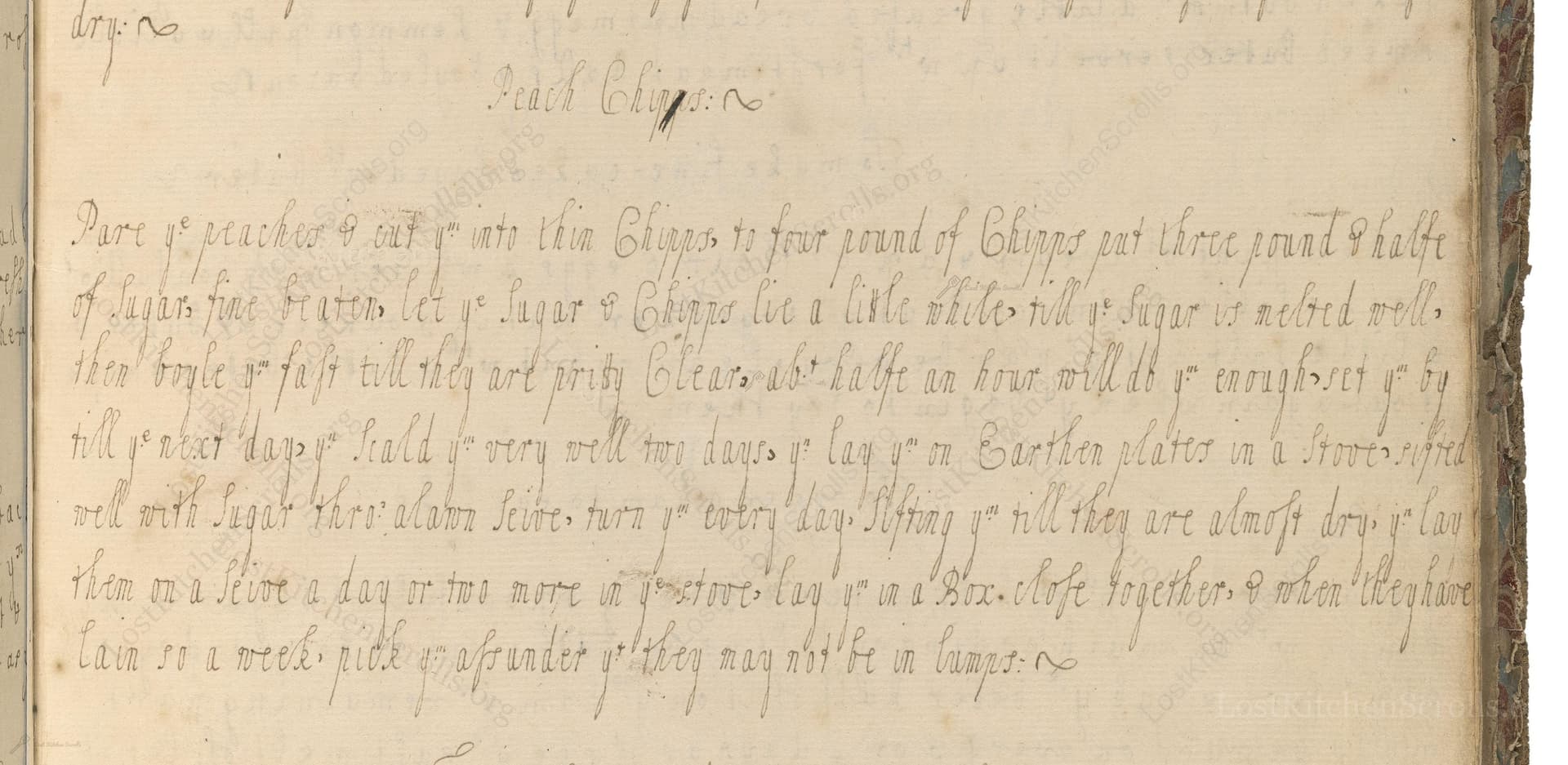Peach Chipps
From the treasured pages of Cookbook of Mary Puleston
Written by Mary Puleston

Peach Chipps
"Pare ye peaches & cut ym into thin Chipps. to four pound of Chipps put three pound & halfe of Sugars fine beaten. let ye Sugar & Chipps lie a little while. till ye Sugar is melted well. then boyle ym fast till they are pritty Clear. abt halfe an hour will do ye enough. set ym by till ye next day. ye scald ym very well two days. ye lay ym on Earthen plates in a Stove. sifted well with Sugar thro' a lawn Seive. turn ym every day. Sifting ym till they are almost dry. ye lay them on a Seive a day or two more in ye stove. lay ym in a Box. Close together. & when they have lain so a week. pick ym asunder yt they may not be in lumps."
Note on the Original Text
Recipes from this period were written in a conversational, almost shorthand style, reflecting an assumption that the reader already had basic kitchen knowledge. Spelling was highly variable—'ym' stands for 'them', 'boyle' for 'boil', and 'scald' meant to heat without boiling. Measurements were less precise, relying on an experienced cook’s intuition. The instructions blend preservation and candying techniques, typical for fruit recipes before refrigeration was available.

Title
Cookbook of Mary Puleston (1764)
You can also click the book image above to peruse the original tome
Writer
Mary Puleston
Era
1764
Publisher
Unknown
Background
A tantalizing compilation of 18th-century culinary wisdom, this collection artfully preserves the flavors, techniques, and charms of British cookery before 1764—inviting modern gourmets to savor a taste of history with every recipe.
Kindly made available by
Folger Shakespeare Library
This recipe for 'Peach Chipps' comes from the manuscript of Mary Puleston, compiled before 1764. Such recipes were typical of 18th-century English households, when preserving seasonal fruit with sugar was both a culinary tradition and a necessity to ensure supplies throughout the year. The final product—a sugar-candied peach—was both a luxury treat and a display of domestic skill, often served at gatherings or as part of a grand dessert spread. Mary Puleston, likely a member of the Welsh gentry, would have had access to both fresh peaches and large quantities of sugar, reflecting the status and resourcefulness of upper-class kitchens during this era.

In the 18th century, cooks would have used a sharp paring knife or small kitchen knife to peel and slice the peaches, and a large copper or earthenware preserving pan over an open hearth fire to simmer the fruit. Earthenware plates were used for laying out the fruit, and a fine linen or lawn sieve for sifting extra sugar. The stove mentioned would be either a heated drying chamber or a bread oven with retained heat. Finally, wooden or tin boxes lined with paper would store the finished chips.
Prep Time
40 mins
Cook Time
1 hr
Servings
30
We've done our best to adapt this historical recipe for modern kitchens, but some details may still need refinement. We warmly welcome feedback from fellow cooks and culinary historians — your insights support the entire community!
Ingredients
- 4 lb ripe peaches (about 8–10 large peaches)
- 3.5 lb (about 7 cups) granulated sugar, plus extra for sifting
- Optional: additional parchment paper or baking mesh for drying
Instructions
- Begin by peeling ripe peaches and slicing them into thin chips, about 1/8–1/5 inch thick.
- For each 4 pounds of peach slices, add 3.5 pounds (about 7 cups) of finely granulated sugar.
- Let the peaches and sugar rest together until the sugar draws out the juice and mostly dissolves, forming a thick syrup—about 1–2 hours.
- Transfer the mixture to a large pot and boil it vigorously for around 30 minutes, or until the peach chips become almost translucent but still hold their shape.
- Allow the mixture to cool and rest overnight.
- On the following two days, reheat the fruit gently—scalding but not boiling—to preserve their texture.
- Next, arrange the peach chips on ceramic or oven-safe plates, placing them in a warm (140–160°F) oven or dehydrator.
- Sift additional sugar over the chips through a fine sieve.
- Turn the chips daily, re-sifting each time, until they are nearly dry (about 2–3 days).
- Transfer the now-sticky chips onto mesh racks or sieves and continue to dry for 1–2 more days.
- Once dried, pack the chips closely in a box for a week, then gently separate them so they do not clump together.
Estimated Calories
150 per serving
Cooking Estimates
You will spend about 30 minutes boiling the peaches, plus two gentle reheats of 15 minutes each on the following days. Preparing and slicing peaches and mixing with sugar takes about 40 minutes. Drying in the oven or dehydrator requires 3-5 days, but this is mostly passive time. Each serving is about 40 grams and contains approximately 150 calories.
As noted above, we have made our best effort to translate and adapt this historical recipe for modern kitchens, taking into account ingredients nowadays, cooking techniques, measurements, and so on. However, historical recipes often contain assumptions that require interpretation.
We'd love for anyone to help improve these adaptations. Community contributions are highly welcome. If you have suggestions, corrections, or cooking tips based on your experience with this recipe, please share them below.
Join the Discussion
Rate This Recipe
Dietary Preference
Main Ingredients

Den Bockfisch In Einer Fleisch Suppen Zu Kochen
This recipe hails from a German manuscript cookbook compiled in 1696, a time whe...

Die Grieß Nudlen Zumachen
This recipe comes from a rather mysterious manuscript cookbook, penned anonymous...

Ein Boudain
This recipe comes from an anonymous German-language manuscript cookbook from 169...

Ein Gesaltzen Citroni
This recipe, dating from 1696, comes from an extensive anonymous German cookbook...
Browse our complete collection of time-honored recipes



